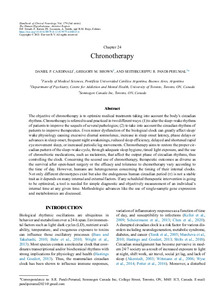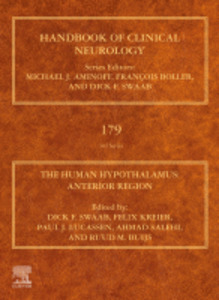Por favor, use este identificador para citar o enlazar este ítem:
https://repositorio.uca.edu.ar/handle/123456789/16497| Título: | Chronotherapy | Autor: | Cardinali, Daniel Pedro Brown, Gregory M. Pandi Perumal, Seithikurippu R. |
Palabras clave: | CRONOTERAPIA; TRATAMIENTO MEDICO; RITMO CIRCADIANO; SUEÑO; MELATONINA | Fecha de publicación: | 2021 | Editorial: | Elsevier | Cita: | Cardinali, D.P., Brown, G.M., Pandi Perumal, S.R. Chronotherapy [en línea]. En: Dick F. Swaab, F.K., Lucassen, P.J., Salehi, A., Buijs, R.M., (eds.). Handbook of Clinical Neurology. Vol. 179. Elsevier, 2021 doi:10.1016/B978-0-12-819975-6.00023-6 Disponible en: https://repositorio.uca.edu.ar/handle/123456789/16497 | Resumen: | Abstract: The objective of chronotherapy is to optimize medical treatments taking into account the body's circadian rhythms. Chronotherapy is referred to and practiced in two different ways: (1) to alter the sleep–wake rhythms of patients to improve the sequels of several pathologies; (2) to take into account the circadian rhythms of patients to improve therapeutics. Even minor dysfunction of the biological clock can greatly affect sleep/wake physiology causing excessive diurnal somnolence, increase in sleep onset latency, phase delays or advances in sleep onset, frequent night awakenings, reduced sleep efficiency, delayed and shortened rapid eye movement sleep, or increased periodic leg movements. Chronotherapy aims to restore the proper circadian pattern of the sleep–wake cycle, through adequate sleep hygiene, timed light exposure, and the use of chronobiotic medications, such as melatonin, that affect the output phase of circadian rhythms, thus controlling the clock. Concerning the second use of chronotherapy, therapeutic outcomes as diverse as the survival after open-heart surgery or the efficacy and tolerance to chemotherapy vary according to the time of day. However, humans are heterogeneous concerning the timing of their internal clocks. Not only different chronotypes exist but also the endogenous human circadian period (τ) is not a stable trait as it depends on many internal and external factors. If any scheduled therapeutic intervention is going to be optimized, a tool is needed for simple diagnostic and objectively measurement of an individual's internal time at any given time. Methodologic advances like the use of single-sample gene expression and metabolomics are discussed. | URI: | https://repositorio.uca.edu.ar/handle/123456789/16497 | ISSN: | 0072-9752 | Disciplina: | MEDICINA | DOI: | 9780128199756 10.1016/B978-0-12-819975-6.00023-6 |
Derechos: | Acceso abierto | Fuente: | Dick F. Swaab, F.K., Lucassen, P.J., Salehi, A., Buijs, R.M., (eds.). Handbook of Clinical Neurology. Vol. 179. Elsevier, 2021 |
| Aparece en las colecciones: | Libros o partes de libro |
Ficheros en este ítem:
| Fichero | Descripción | Tamaño | Formato | |
|---|---|---|---|---|
| chronotherapy-cardinali.pdf | 284,17 kB | Adobe PDF |  Visualizar/Abrir | |
| cover.gif | 24,81 kB | GIF |  Visualizar/Abrir |
Visualizaciones de página(s)
43
comprobado en 27-abr-2024
Descarga(s)
247
comprobado en 27-abr-2024
Google ScholarTM
Ver en Google Scholar
Altmetric
Altmetric
Este ítem está sujeto a una Licencia Creative Commons

